Fish 1 + 2
1/94
There's no tags or description
Looks like no tags are added yet.
Name | Mastery | Learn | Test | Matching | Spaced |
|---|
No study sessions yet.
95 Terms
What is aquaculture?
Farming of aquatic organisms, including fish, molluscs, crustaceans and aquatic plants in a controlled/semi-controlled environment.
What different water types can be used in aquaculture?
- Freshwater
- Marine
- Brackish - low salinity
Types of aquaculture systems: (lowest to highest intensity)
- Ponds
- Cages
- Raceways
- Recirculating aquaculture systems (RAS)
What are the 4 basic requirements in aquaculture production?
- Water: volume and quality.
- Oxygen:
- Food
- Waste Removal
waste removal for aquaculture
generally falls through the bottom of cage/pond/tank, but depends on water movement,
flow rate should occur at a rate that removes waste quickly enough so that waste doesn't build up and harm the fish.
For ammonia production algae and bacteria can be used but if the system is intense then biofilters can be used. even low amounts of ammonia can cause stress
food sources for aquaculture
Natural sources (filter feeders)
Livefeeds
Formulated feeds
Others: whole fish, BIOFloc
Feeders: mechanical or demand
oxygen sources for aquaculture
natural ( photosynthesis of green algae) or artificial (oxygen injectors and aerators/diffusers, for example in raceways, falling water causes splashes and diffusion of water from the air).
water sources for aquaculture and what does it need to be
sea, wells, rainwater, watershed runoff, springs, streams, lakes locks
have the adequate voluma
what is solid waste, what can it do and what needs to be done
Solid waste: from uneaten feed, dead fish and faeces
Need to be removed as they can be harmful to fish
can Clog gills -> death
if Left for long time -> inrcs in unsuspended and unsuspended solids, bact and ammonia in water
what normally happens to ammonia
Is normally taken in by algae and bacteria and broken down
Depending on intensity of the system, biofilters might be needed to help remove nitrogenous waste
what is the flow rate and what does it need to be
rate at which the water is replaced by new water
needs to be sufficient to not allow the waste products to build up
What is the first stage of the aquaculture production cycle?
Broodstock

What is the second stage of the aquaculture production cycle?
Hatchery
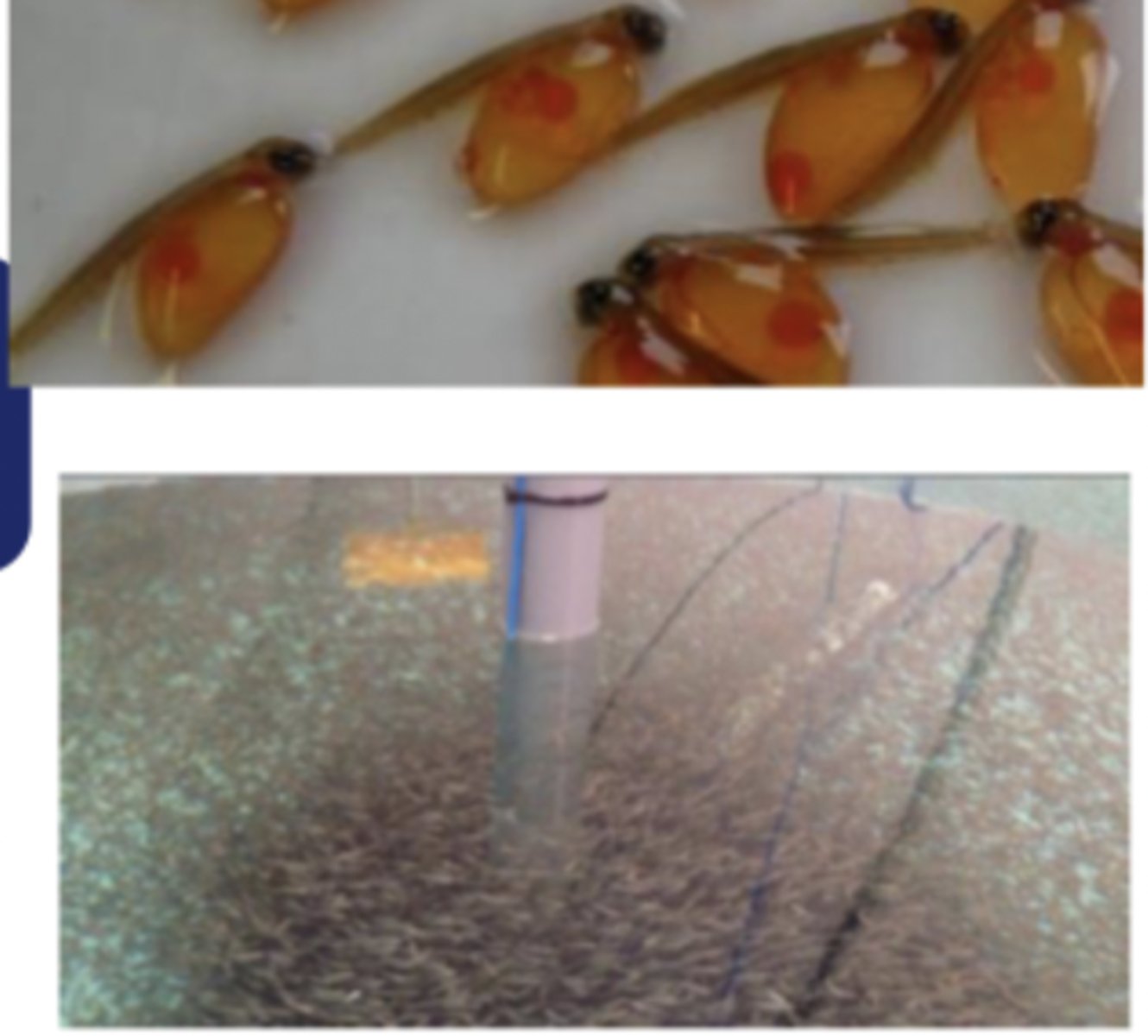
What is the third stage of the aquaculture production cycle?
Grow-out

What is the final stage of the aquaculture production cycle?
Slaughter
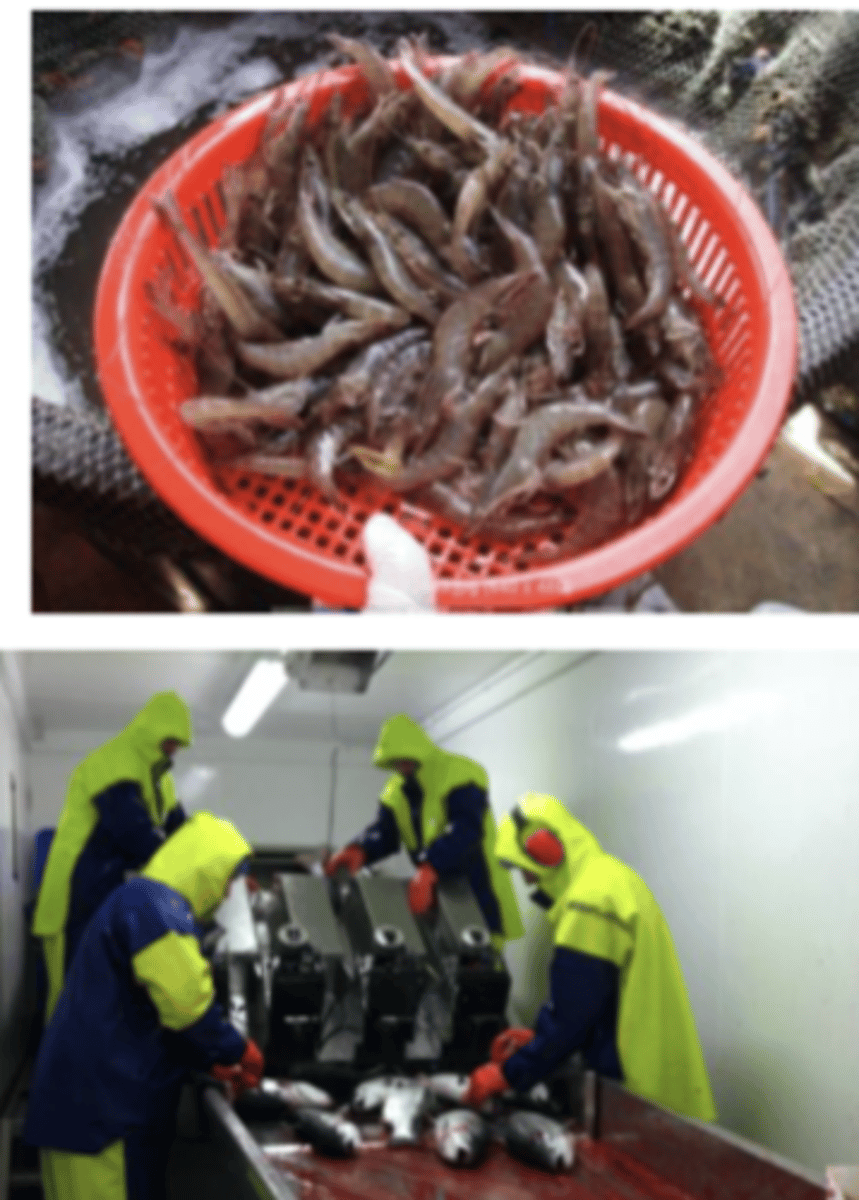
How are production plans for aquaculture companies generally calculated?
In degree days, considering temperature and number of days.
number of days x temp
Why is temperature important in aquaculture production?
Fish are ectotherms and their growth is affected by temperature.
system of growing stock in aquaculture - basic atlantic salmon
broodstocked selected from farmed or wild pop.
induce spawining - light and temp manipulation
disease screening
ova are stripped
freshwater hatchery
incubated in troughs
fry - parr -
naturally or light manipulation turning into smolts
moved by boat or helicopter to where they will grow out
most vulnerable to environmental and disease pressure

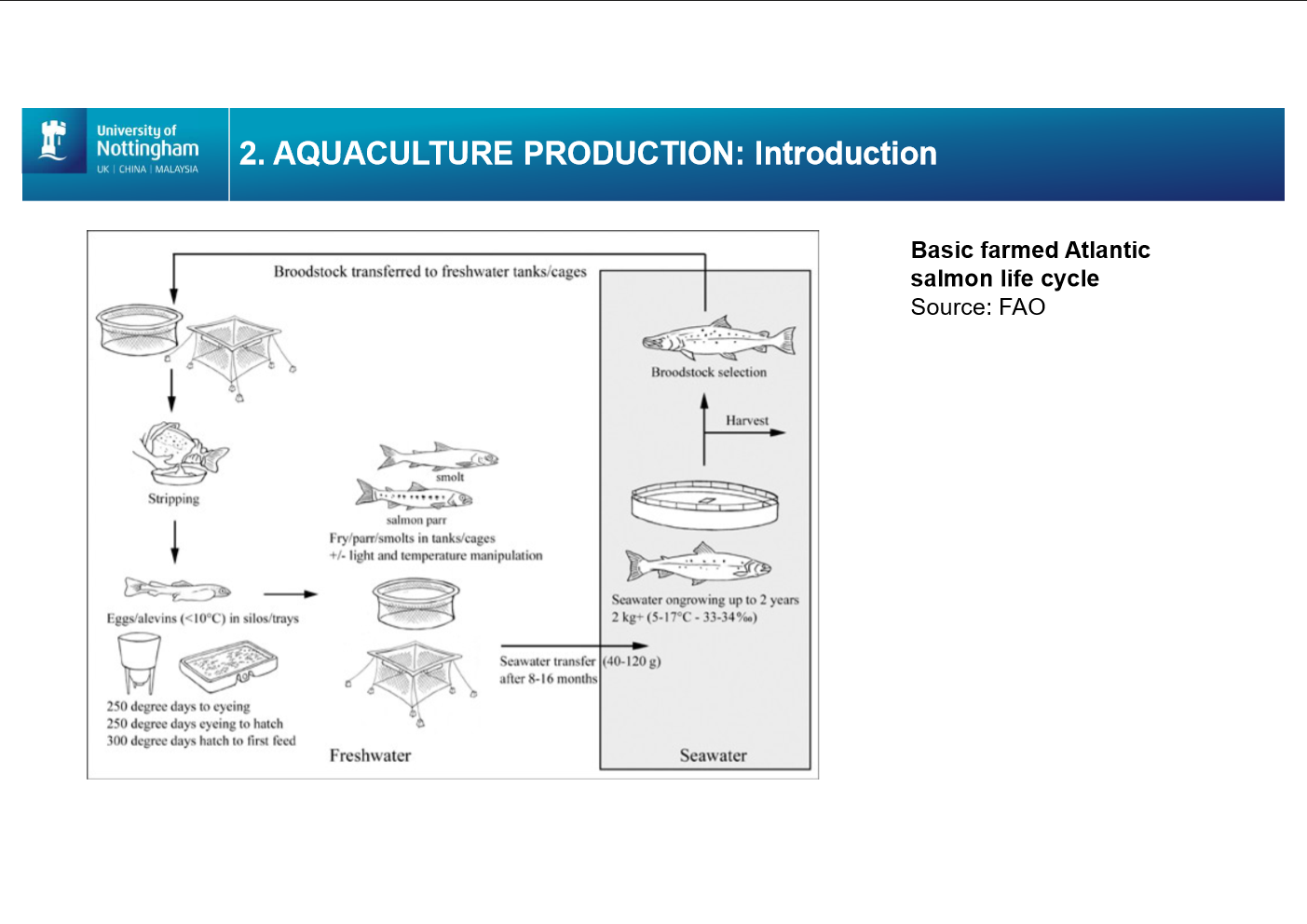
why might you do disease screening in the cycle
to make sure not
smoltification
body change shap and colour
upregulation
sodium potassium atpase pumps in gills and skin -
can now live at sea
What are the three stages of molluscan shellfish production?
1. production of seed (eggs).
2. Juvenile nursery culture.
3. Grow-out of sub-adults to harvest size.
What are the two methods for production of seed (eggs) in shellfish production?
Hatchery production from selected broodstock and seed collection from natural resources.
What are the locations for juvenile nursery culture in shellfish production?
Land-based flow through systems, floating/submerged nets or trays in intertidal ponds, and floating/submerged nets or trays in open water.
Where does the grow-out of sub-adults to harvest size occur in shellfish production?
In open waters, offshore, coastal ponds, or intertidal areas.
What are the methods used for grow-out of sub-adults to harvest size in shellfish production?
On-bottom/off-bottom poles or racks, floating rafts, longline systems, and cages or nets.
Summary of pond systems.
- Enclosed water areas
- Most commonly used
- Least intense
- Rely on natural processes to remove waste and supply oxygen

What species of fish are commonly kept in pond systems?
- Salmonids
- Tilapia
- Shrimp/Prawns
- Catfish
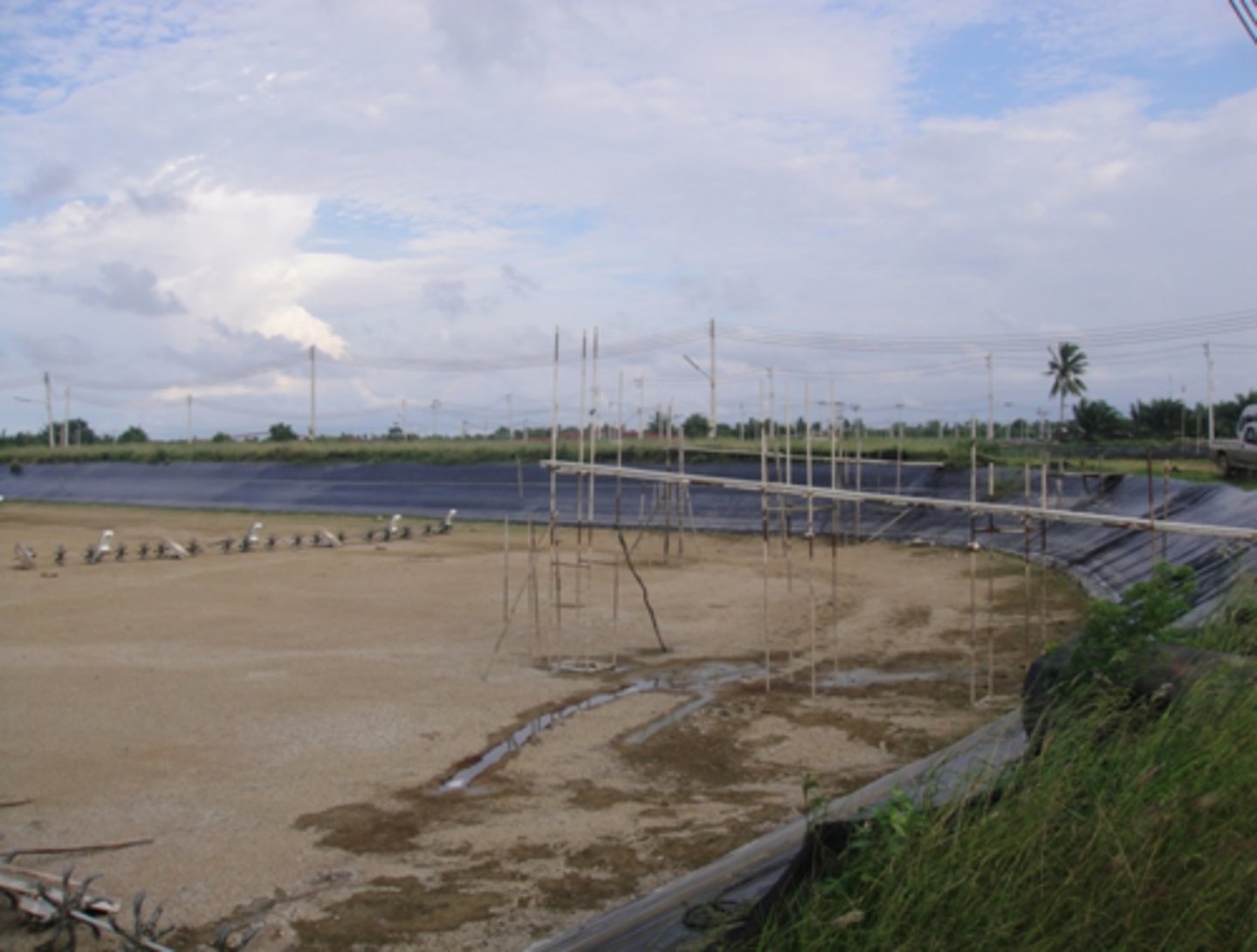
Summary of cage types
- Circular or squared
- Variable sizes
- Soft or hard materials
fixed to sea bed below
majority of atlantic salmon
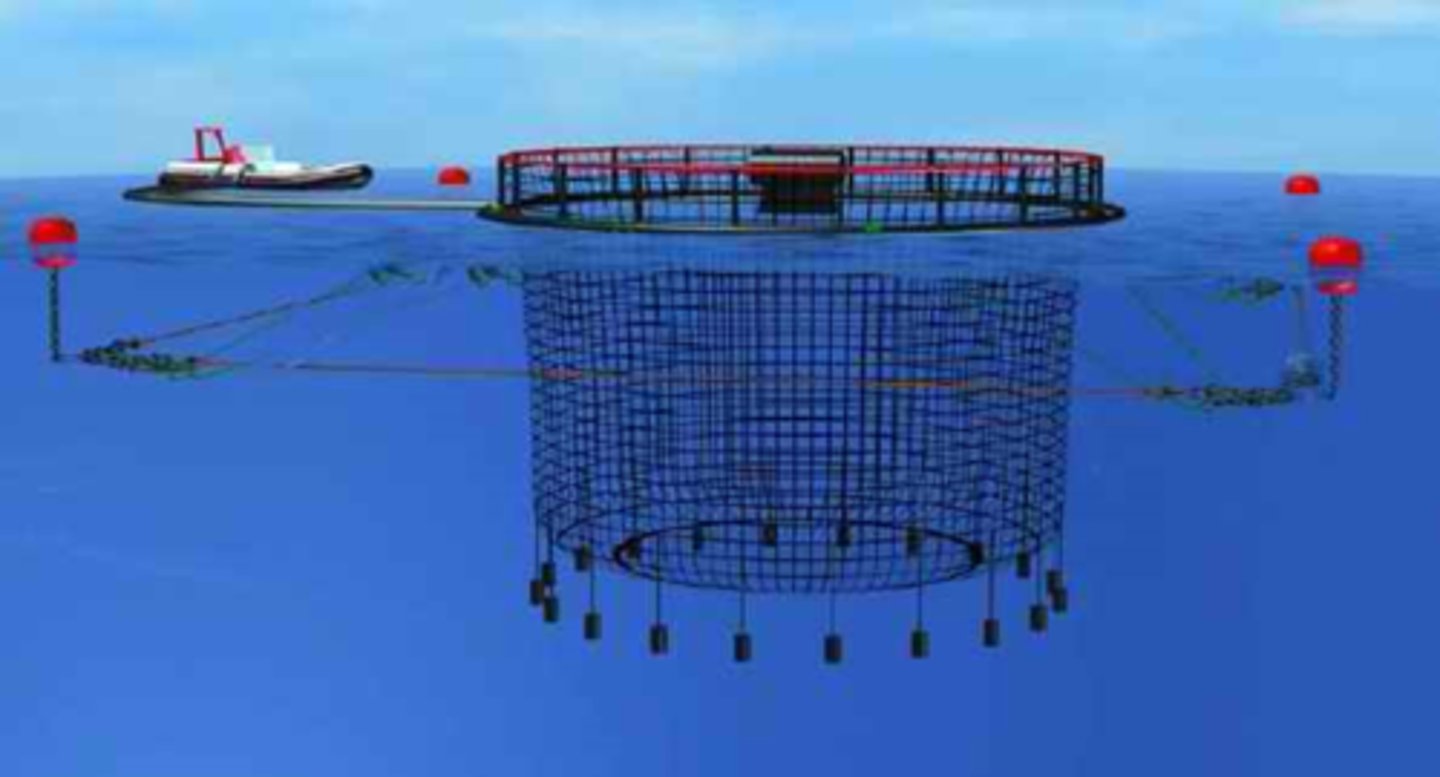
Advantages of cages.
- Easy stocking
- Easy feeding
- Easy harvest
Disadvantages of cages.
- Little environmental control, meaning:
- Susceptible to predators
- Exposure to water-borne irritants (jellyfish, plankton blooms)
- Exposure to bad weather conditions
- Shared water body (quicker disease spread) - sea lice
- Limited water quality control.
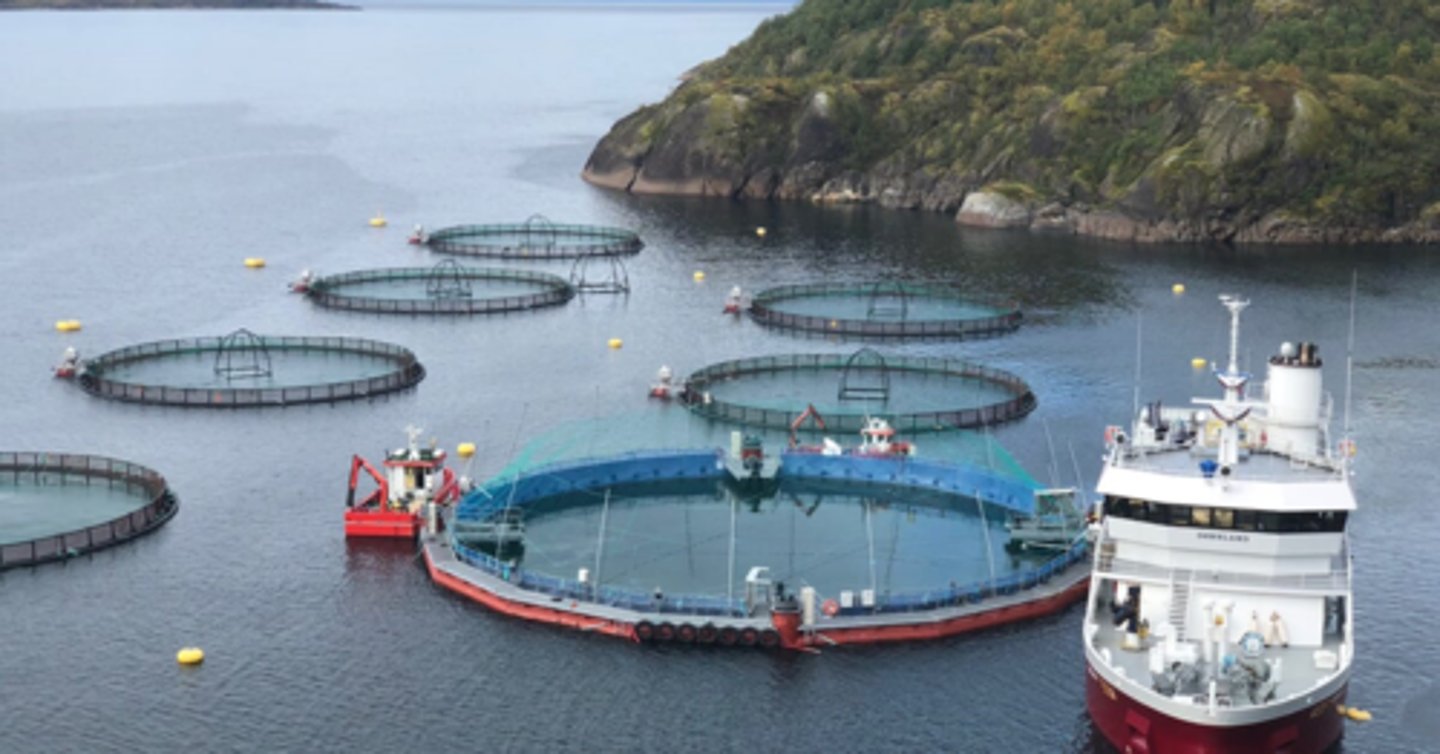
What species of fish are commonly kept in cage systems?
- Salmonids
- Tilapia
- Seabass
- Seabream
- Tuna
Summary of sea cages.
- Much larger than normal cages
- More robust
-have a higher vol of water
- 'Movable' (as long as you have a licence to do so)

Summary of raceways.
- Rectangular structures
- Single pass system
- Built above or below ground
- Cement, fibreglass or wood
- Require large volumes of water that is high quality
- Gravity flow
Tend to be in mountainous regions (e.g. Idaho).
- more intense

Disadvantage of raceways.
- Water flows from one sub-unit to the next without treatment. Not ideal from a biosecurity perspective.
- To minimise disease risk, the fish getting the fresher water are the younger stages and theoretically, the largest and most robust fish will be located at the bottom of the farm.
- require a lot of water - needs to be high quality
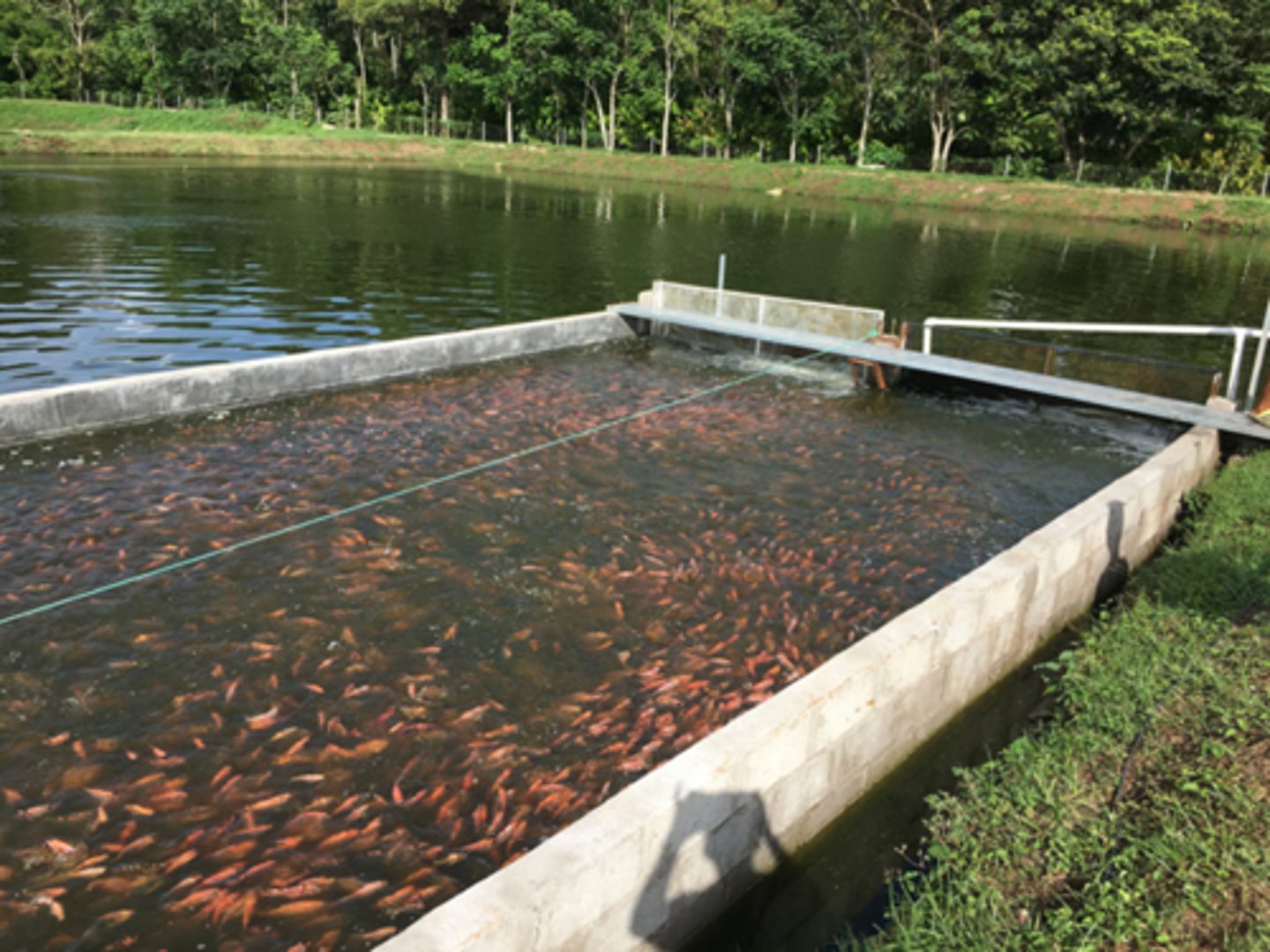
What species of fish are commonly kept in raceways?
- Trout
- Tilapia
- Carp
- Prawns
Summary of recirculation aquaculture systems (RAS).
- Most intensive system
- Can be located almost anywhere
- Less water requirement
- Significant energy input
- Required expertise
- Expensive
- can be set up in most areas
Waste water is cleaned through a series of mechanical and biological filters and then put back into the system.
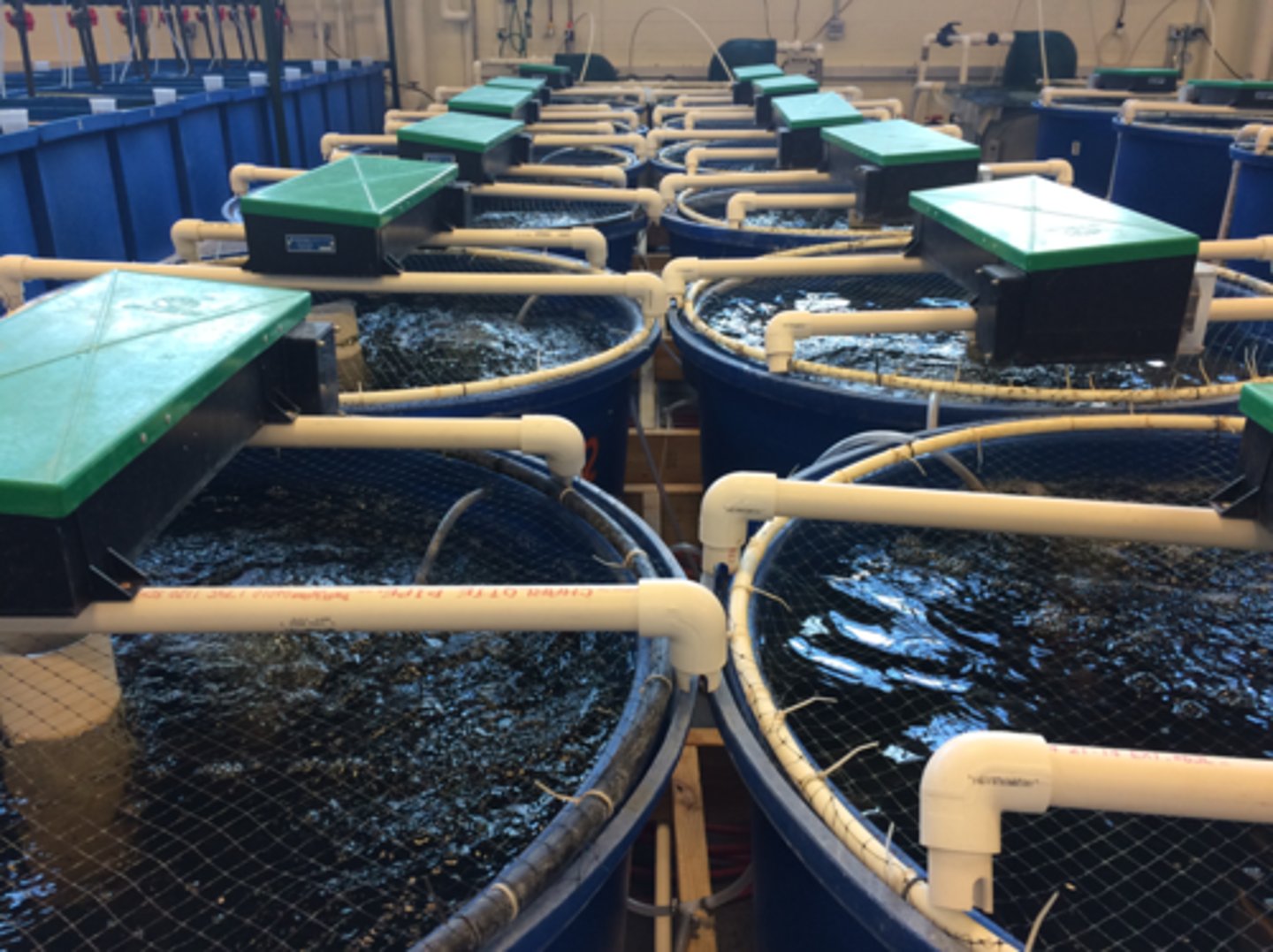
Disadvantage of RAS systems.
Recirculation of water can quickly magnify pathogen challenges - critically important to screen fish for disease before being brought into these facilities.
pathogens cause more acute illness
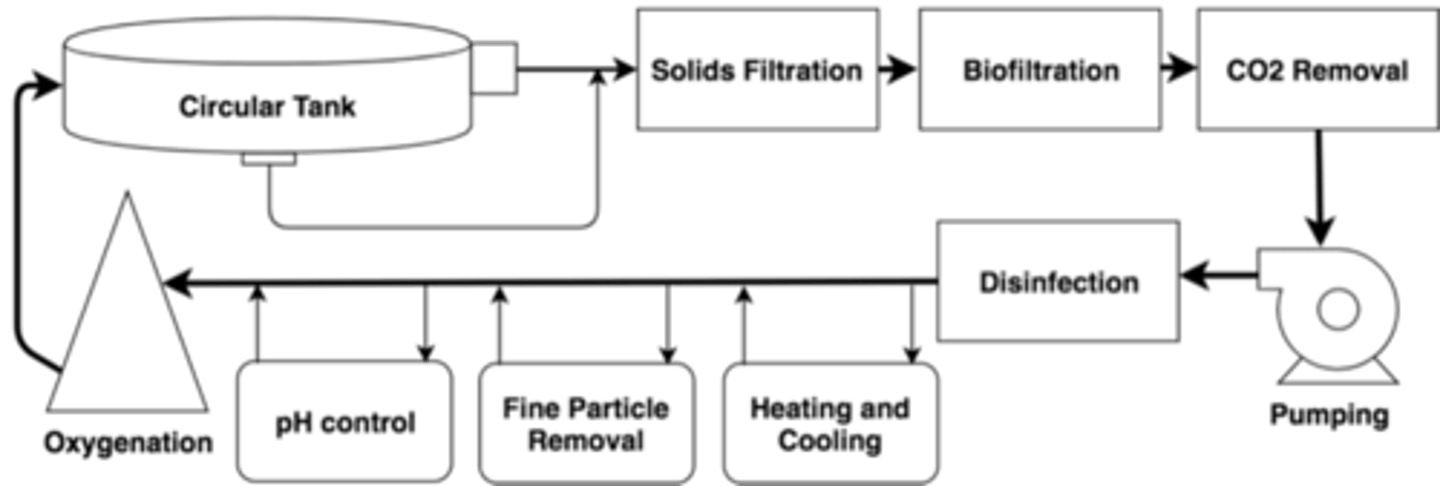
What do RAS systems require?
- culture tanks
- filter to remove solids
- biological filter - ammonia
- oxygenation equipment → o2 addition is v important
- co2 removal
- heating + cooling
- pH control
- pumping
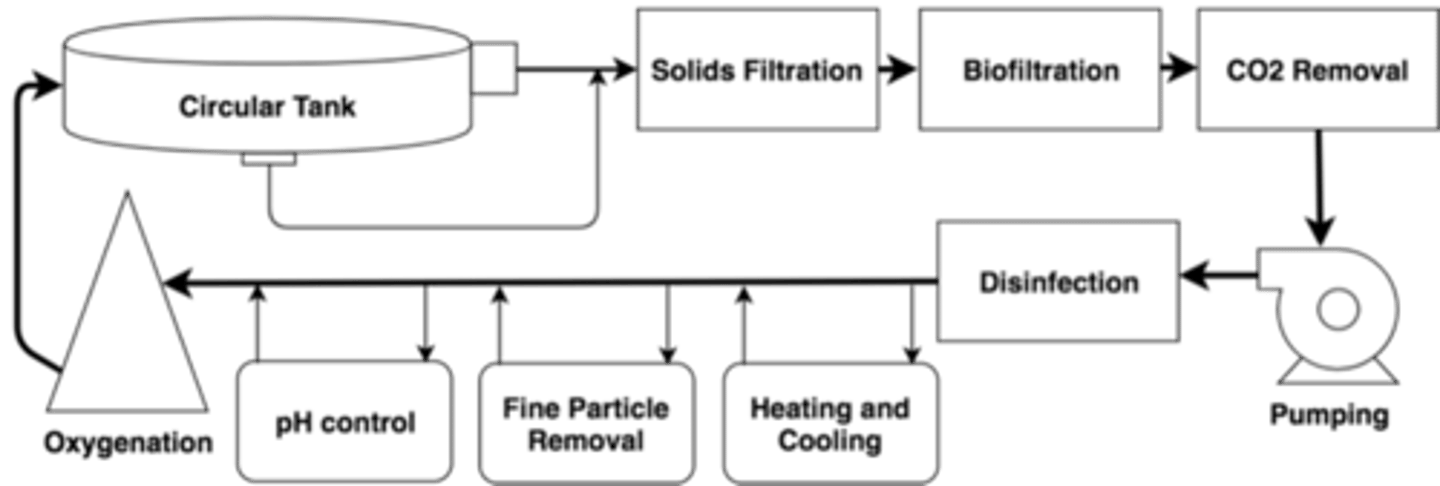
What species of fish are commonly kept in RAS systems?
- Salmon
- Trout
- Eel
- Sturgeon
- Arctic char
- Yellowtail
What other less common aquaculture systems are there?
- Offshore aquaculture
- Semi-closed systems
systems which are being trialled
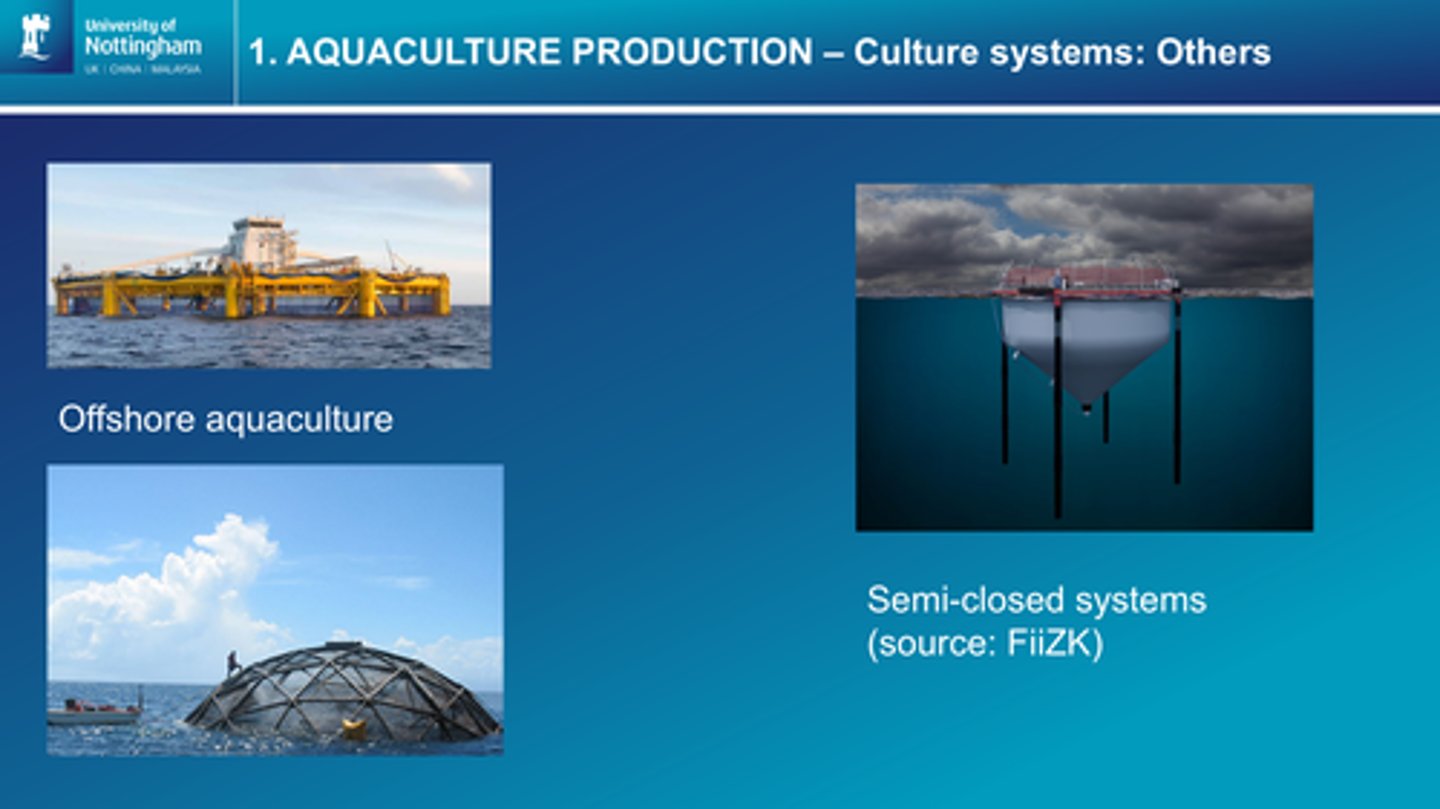
Why is fish welfare important?
Good welfare conditions --> less stress and disease susceptibility --> less dependence on medication/treatments --> better growth rates and food conversion --> better quality product
What looks after the welfare of fish in aquaculture?
-Major resource published 2018 by NOFIMA: 'Fishwell' report
-Operational Welfare Indicators (OWIs) proposed for fish
What is the definition of welfare?
The physical and mental state of an animal in relation to its environment. It requires:
- The animal's normal biological functioning
- Its emotional state
- Its ability to express certain normal behaviours
Do fish feel pain?
This is debated, however, the summary is that there are two main processes:
- Nociception
- Conscious recognition (unclear)
- Brain anatomy
Fish can show 'emotional fever' - this is stress-induced hyperthermia so indicates some form of emotional state.
How can we assess welfare in fish farms?
Operational welfare indicators (OWIs).
Would assume that if the fish look good, feeding , growing and behaving normally you expect their welfare is good
What are welfare indicators?
Measurable/observable parameters relating to the welfare needs of fish.
What are operational welfare indicators (OWIs)?
Welfare indicators that are judged to have practical application and value on-farm. OWIs can be individual or group-based.
what can OWIs be
What does it mean for OWIs to be clearly defined?
OWIs should have a clear and specific definition.
How should OWIs relate to the welfare state of fish?
OWIs should correlate to the welfare state of the fish or at least one welfare need and be suitable for the life cycle stage and production system in question.
What does it mean for OWIs to be practicable?
OWIs should be feasible to implement.
What is the reliability requirement for OWIs?
OWIs should produce repeatable and comparable results with objective scores.
What types of scoring can OWIs use?
OWIs can be binary (positive/negative) or scalable depending on the indicator.
What is the validation requirement for OWIs?
OWIs should be validated for the species or be above reasonable criticism.
What does it mean for OWIs to be auditable?
OWIs should be capable of being audited.
What are some indirect OWIs?
- Water quality parameters: temp., salinity, oxygenation, total ammonia nitrogen, nitrites, ozone, turbidity, hardness/alkalinity, total gas pressure, suspended solids, water flow.
- Lighting
- Feed quality/load
- Stocking density
- Tank/filter microbiome
what can deviations of indirect OWI mean
Deviations can indicate theres problems before they start to affect the fish
but effects are often dependent on multiple factors and monitoring isnt always realistic
What are the indicators of group-based direct OWIs?
Mortality, Behaviour, Appetite, Growth, Presence of emaciated fish, Blood/scales in water, Discolouration, Presence of disease.
What are the indicators of individual-based direct OWIs?
Opercular movement, gill condition, body condition, sexual maturation, smoltification status, fin condition, skin condition, presence of haemorrhages/wounds, eye conditions, jaw or vertebral deformities.
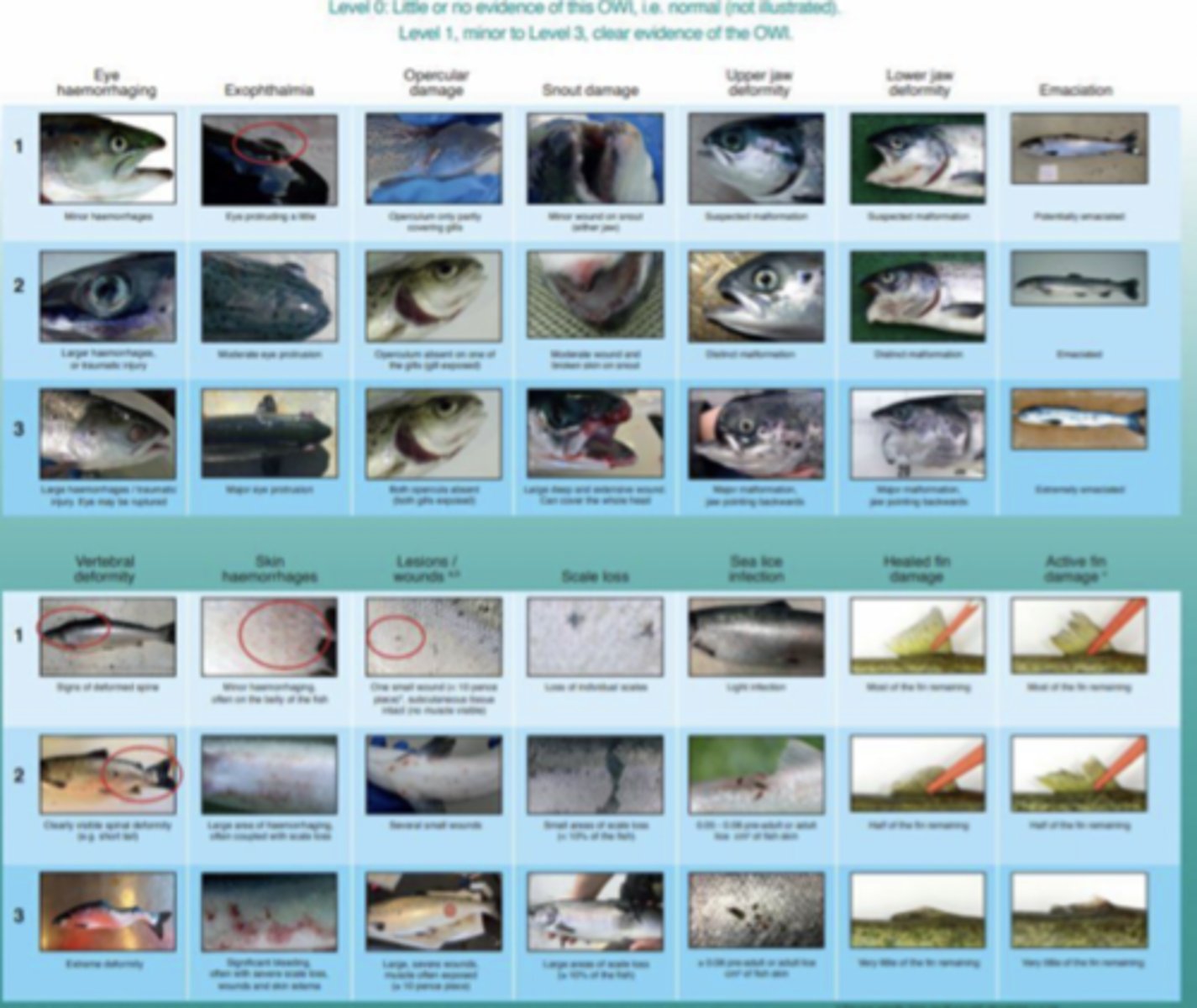
how can OWIs be measured
Scoring systems to help with this
1- Mild changes
3- Severe changes
Do it routinely
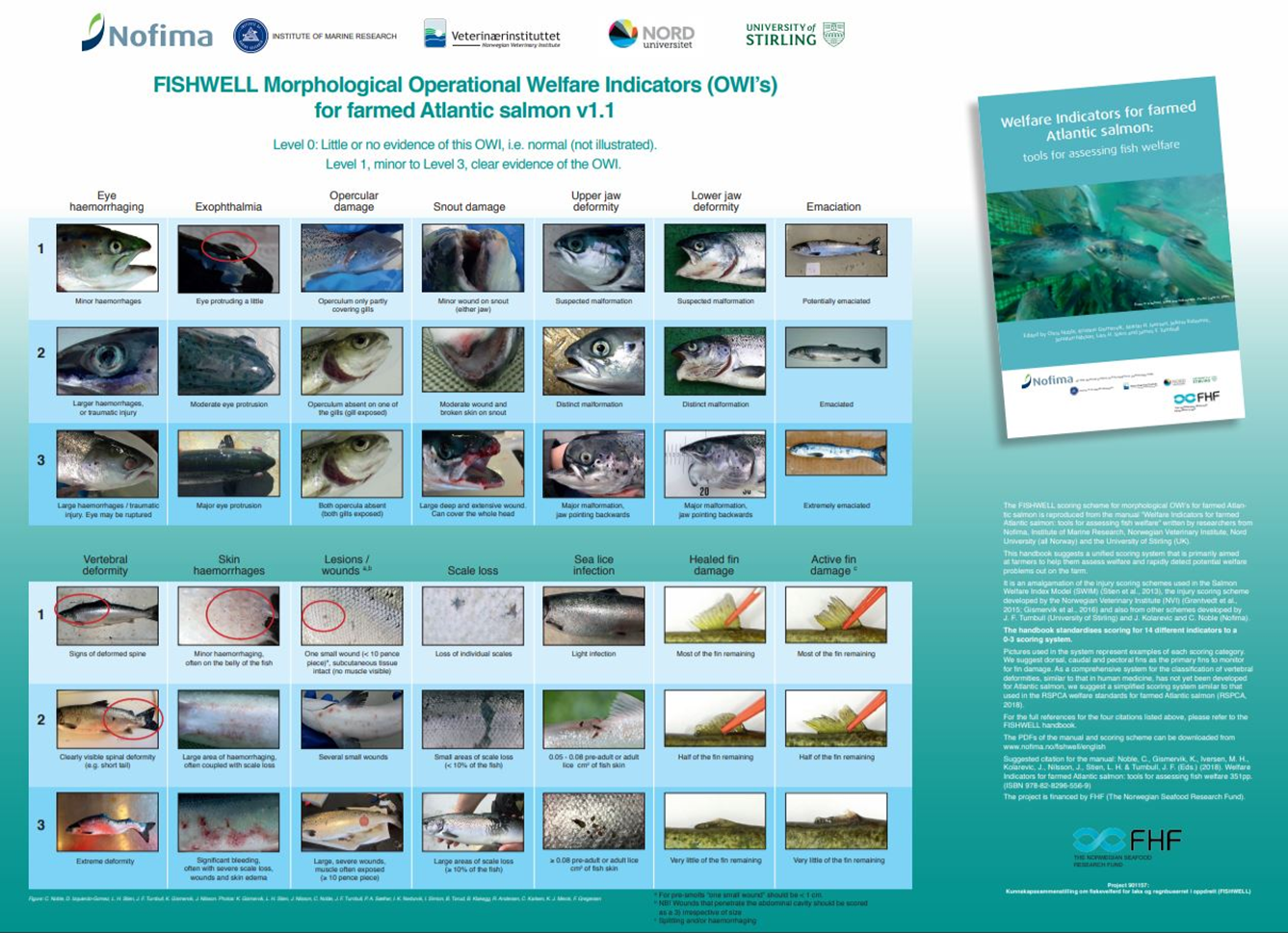
What about crustaceans and molluscs, can they feel pain?
Although fish are protected under the Animal Welfare Act 2006, invertebrate decapods aren't.
Findings from several scientific studies suggest that it is highly likely that decapod crustaceans are 'capable of experiencing pain or suffering'.
What limitations are there to applying animal welfare to aquaculture?
-Fish welfare needs/concepts not yet clearly understood.
-Huge number of species cultured: limited understanding on welfare-related biology.
Regulatory bodies involved in welfare standards in aquaculture.
Globally:
- FAOs Code of Conduct for Responsible Fisheries
- Aquaculture Stewardship Council
- Organic certification schemes (Soil Association)
- Global GAP (Good Aquaculture Practice)
UK:
- RSPCA Assured (salmon, trout, cleaner fish)
- SSPO Code of Good Practice
How can farming in aquatic environments affect public health?
-Pollution of water bodies by increased organic load (through feeding/fertilisation) in the water can lead to survival of pathogens and multiplication of vectors.
-Water bodies represent unique opportunity for spread of anti-microbial resistance (AMR) through easy mixing of bacteria, overuse of antibiotics particularly in countries where veterinary controls are poor.
-In some places the water which fish are reared can be used for multiple things
Hygiene/ washing fascilities for people, disposing of waste ect
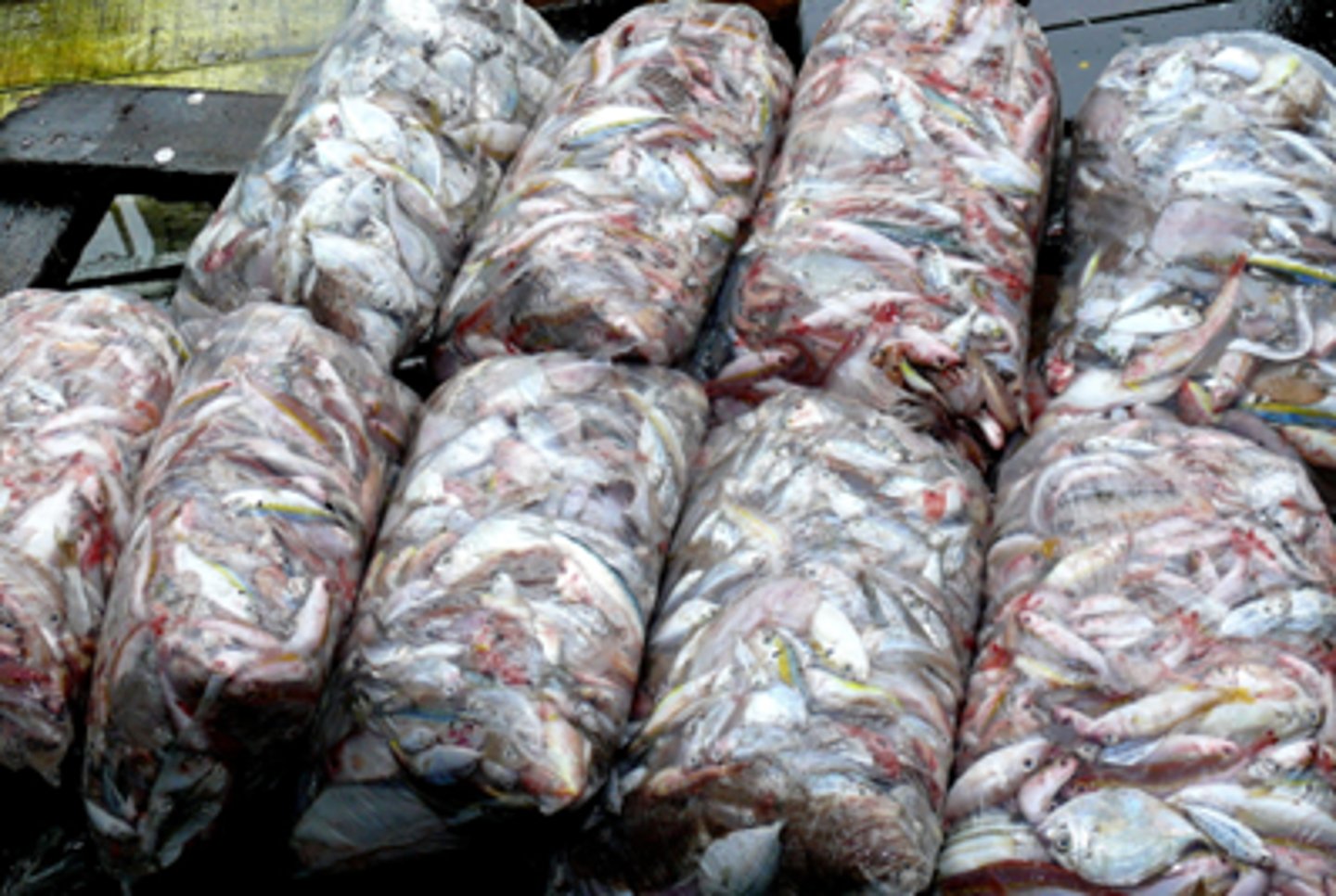
what are UK trout farms required to monitor
the amt of nitrogenous waste into streams or rivers
How can eating aquatic products affect public health via non-infectious contaminants?
-Contamination with veterinary residues
-Contamination with herbicides or pesticides (organochlorine pesticides, organotin compounds, phthalates, brominated flame retardants, polyflourinated compounds, PAHs, dioxins, PCBs, …)
-Contamination with heavy metals Cd, Hg (methylmercury) and Pb
-Biological toxins
how can toxins in wild species be passed to farm species
if they are a food source
Can be monitored
Lots of wild fish is needed to make small vol of feed for farmed
Name some biological toxins produced by shellfish
-Amnesic (ASP)
-Diarrhoeic (DSP)
Paralytc (PSP
Name some biological toxins produced by fish
-Scombrotoxin (histamine poisoning - mackrel and tuna)
due to consuming histadine -> is then coverted to histamine
Is due to spoiling of fish
-Ciguatoxin (tropical sub tropical - barracuda, eels)
-Tetrodotoxin (puffer fish)
How can eating aquatic products affect public health via food and waterborne diseases?
Transmission of pathogenic organisms within water bodies and/or contaminated food.
pathogenic bacteria:
- Clostridium botulinum
- Vibrio parahaemolyticus
- Salmonella
- E.coli
- Listeria monocytogenes
Or pathogenic viruses:
- Norovirus - oysters particularly
Vibrio parahaemolyticus
febrile gastroenteritis
seasonal disease, temperate marine waters
can come through wounds and ingestion of undercooked fish and shell fish
What zoonotic bacteria can humans contract from fish?
-Aeromonas spp.
-Vibrio spp.
-Mycobacterium spp.
-Streptococcus iniae
-Erysipelothrix rhusiopathiae
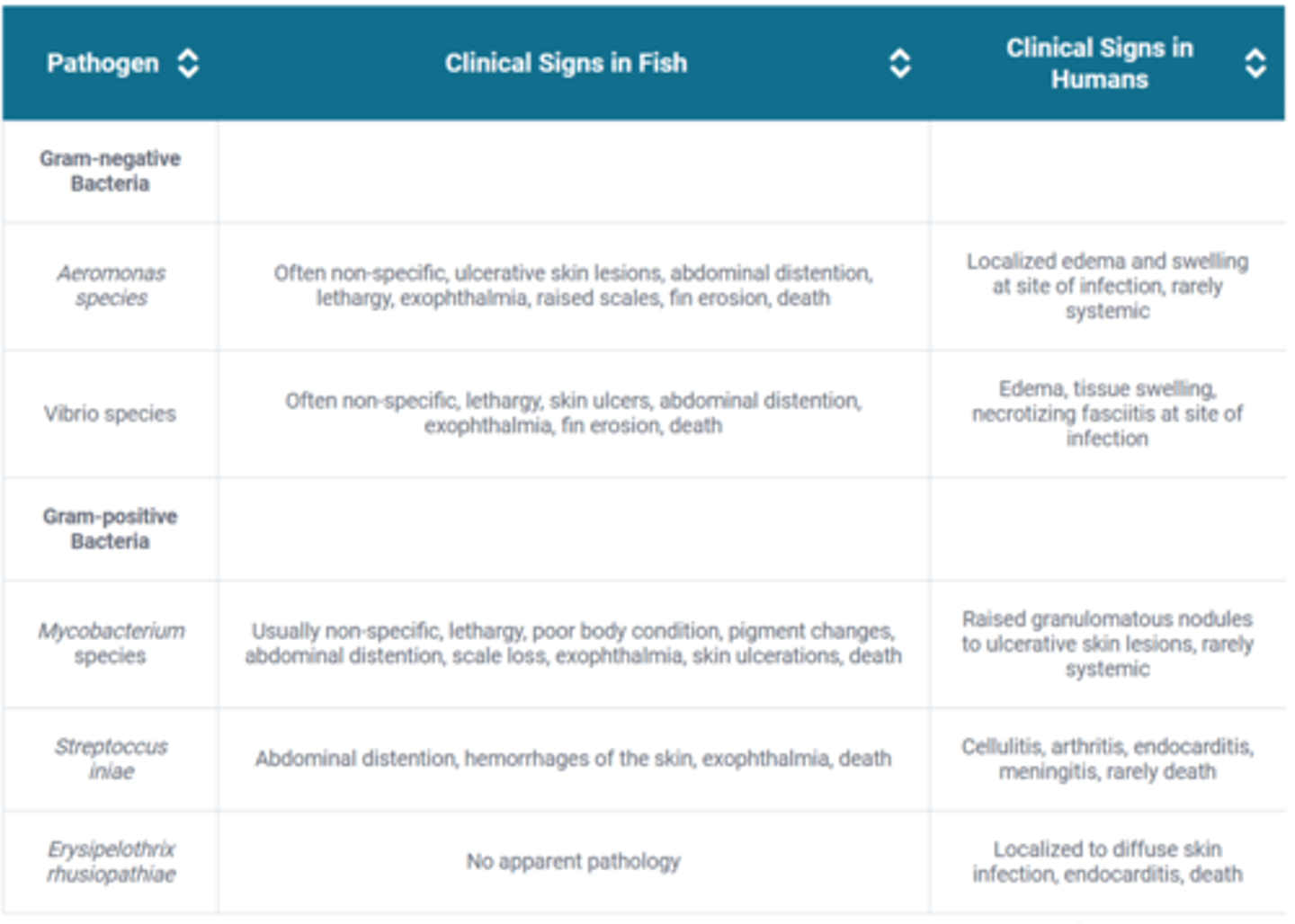
features of clostridium botulinum serotype
where are you more likely to find salmonella spp with fish
High water temperaturas
Contaminated water effluents
theres Salmonella monitoring on some farms and processing plants in uk
what is e coli an indicator of in fish
caecal contamination (human handling)
what are features of listeria monocytogenes in fish
Frequently isolated from fish and fish products – of concern in vulnerable individuals
What zoonotic parasites can humans contract from fish?
-Trematodes: Opisthorchiidae and Heterophyidae
-Nematodes: Anisakidae and Gnathostomidae
-Cestodes: Diphyllobothridae
how would infections develop from contact with farmed fish
wounds when handling fish, contact with mucus and tissue of fish
what zoonotic diseases are there in fish, what clinical signs will be seen in fish and humans
Aeromonas hydrophala most common in fish in uk
Vibrio common in uk due to water temps

What is the most common 'true' bacterial zoonosis from fish?
Three major species (M. marinum, M. fortuitum, M. chelonae, amongst others)
mycobacteriosis
How do three major species (M. marinum, M. fortuitum, M. chelonae, amongst others) of bacteria that is zoonotic manifest in fish and in humans?
-In fish: multiple internal granulomas, low but persistent mortalities, chronic presentation (“fish tuberculosis”)
gram + bacteria colonies
-In humans: superficial skin lesions (“fish handlers disease” or “fish tank granuloma”) and systemic mycobacteriosis in immunocompromised individuals. respiratory symptoms
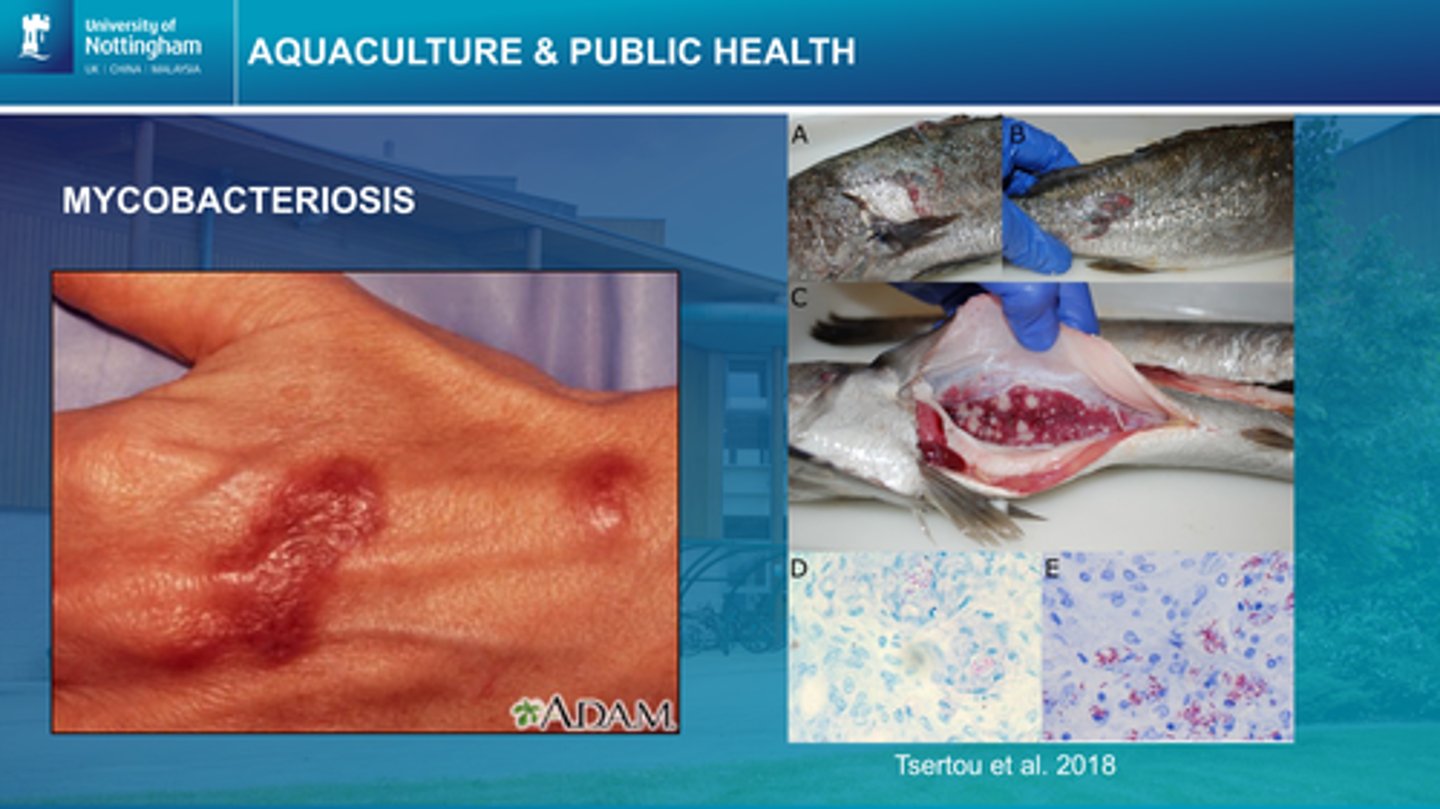
Describe the life cycle of Diphyllobothrium spp (cestode)
widespread
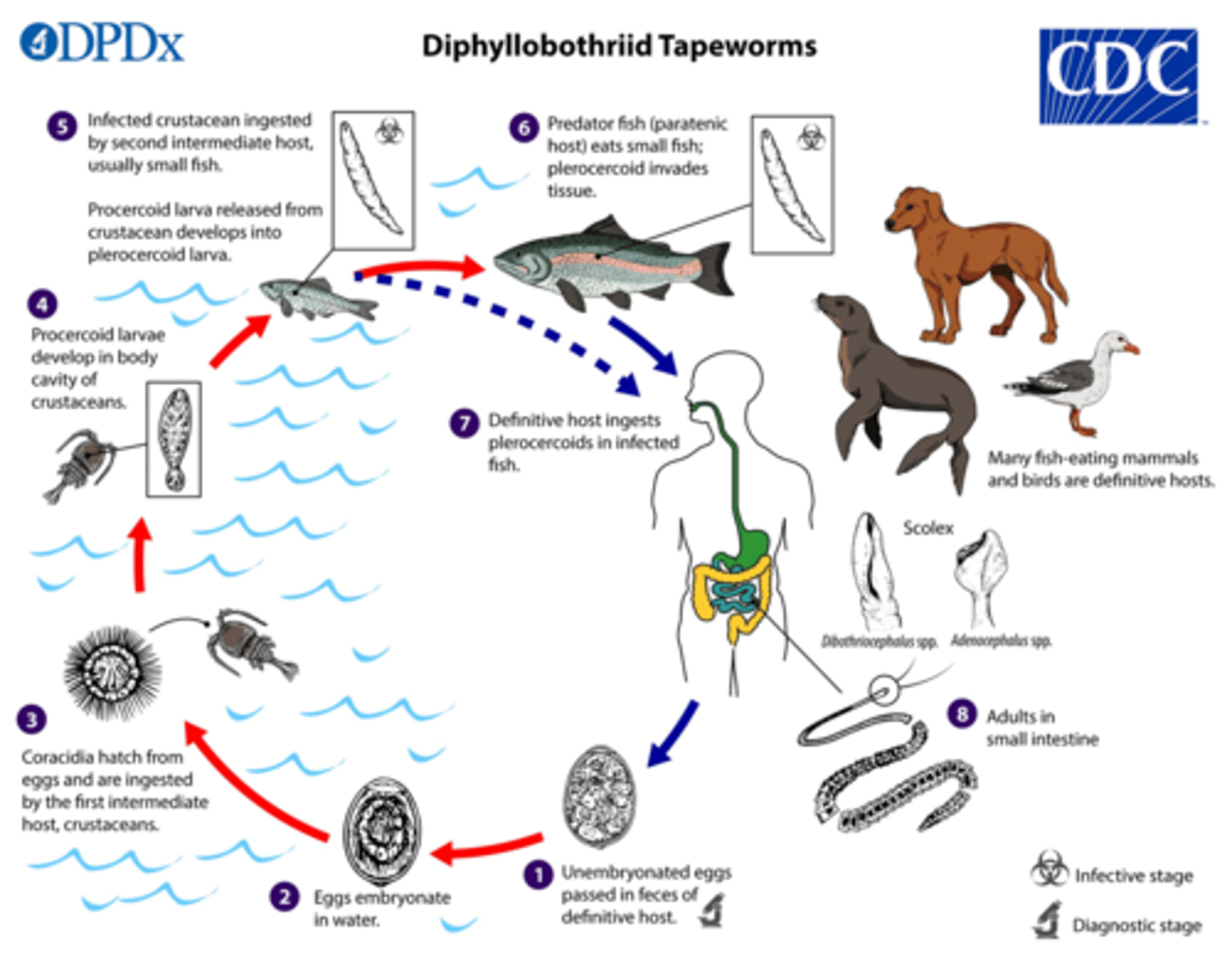
How can you see Diphyllobothrium spp in fish post mortem?
The cysts of Diphyllobothrium are white and clearly evident on the intestine of fish.

How can humans prevent contracting Diphyllobothrium spp. (cestode) from fish?
By properly cooking and freezing of fish.
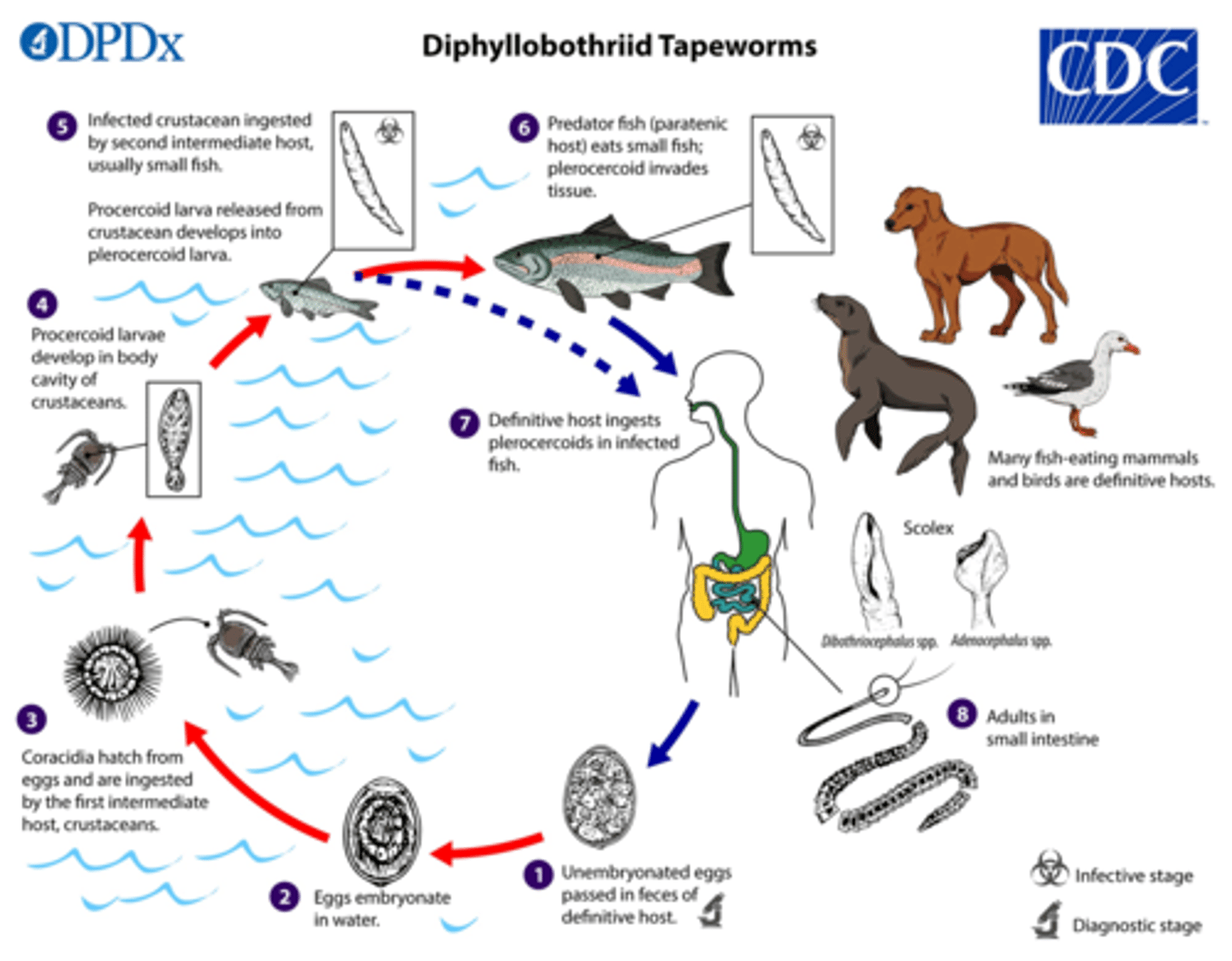
describe the lifecycle of diphyllobothrium spp. (cestode)
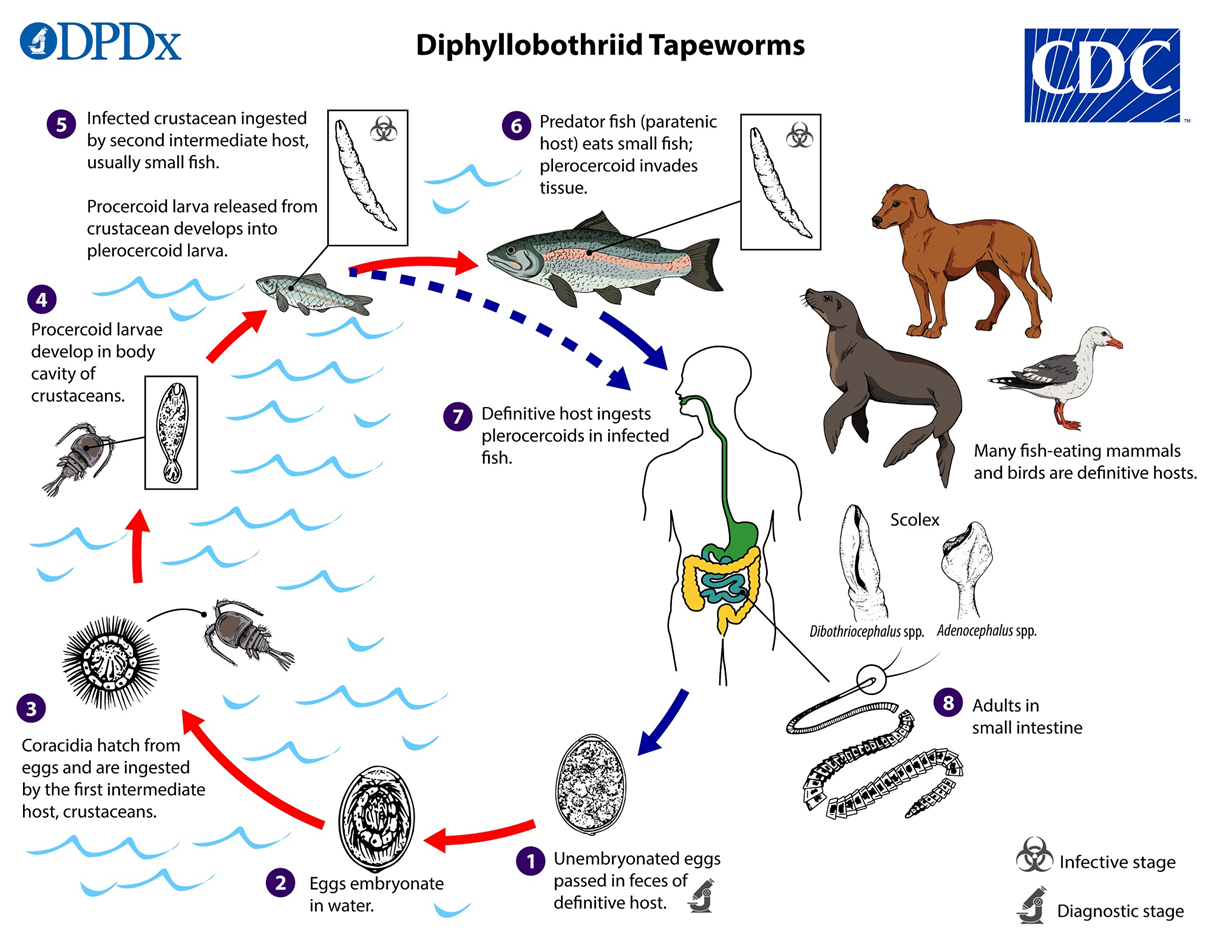
what can cause anisakiasis
Anisakis (A. simplex),
Pseudoterranova (P. decipiens)
Contracaecum (C. osculatum)
Describe the lifecycle of this nematode Anisakis (A. simplex)
dolphins are usually the final host -> become infected when they eat infected fish
But if humans eat an infected fish (undercooked) -> burrow into lining of GIT -> inflam reaction
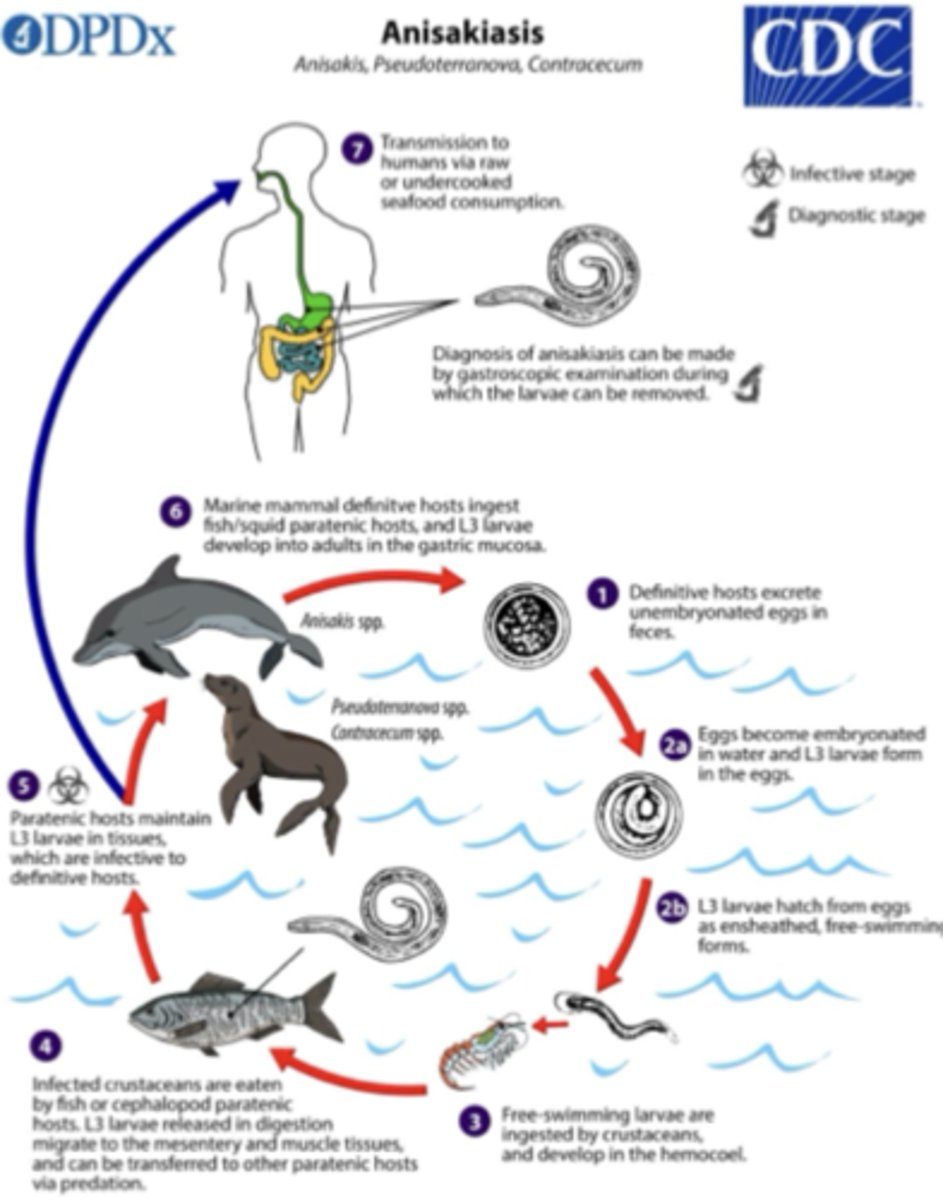
why is anisakiasis mainly a problem in wild fish
Bc farmed fish arent eating the intermediate host (shrimp ect) so don’t get the infection
how can you see if fish are infected with a.simplex
Shine light under the fillet and remove the worms if present
Describe Anisakis (A. simplex) effect and how it's spread it's controlled:
Causes: ingestion of larvae through the intermediate host
-Raw (sushi), rare (slightly cooked) or inadequately processed
Effects:
-Anisakiasis (gastrointestinal irritation of live larvae)
-Allergy to A. simplex larvae when they are ingested (like an allergic reaction to seafood in someone with no previous allergic reaction to seafood)
Control:
- Freezing and heat treatments (EFSA recommendations)
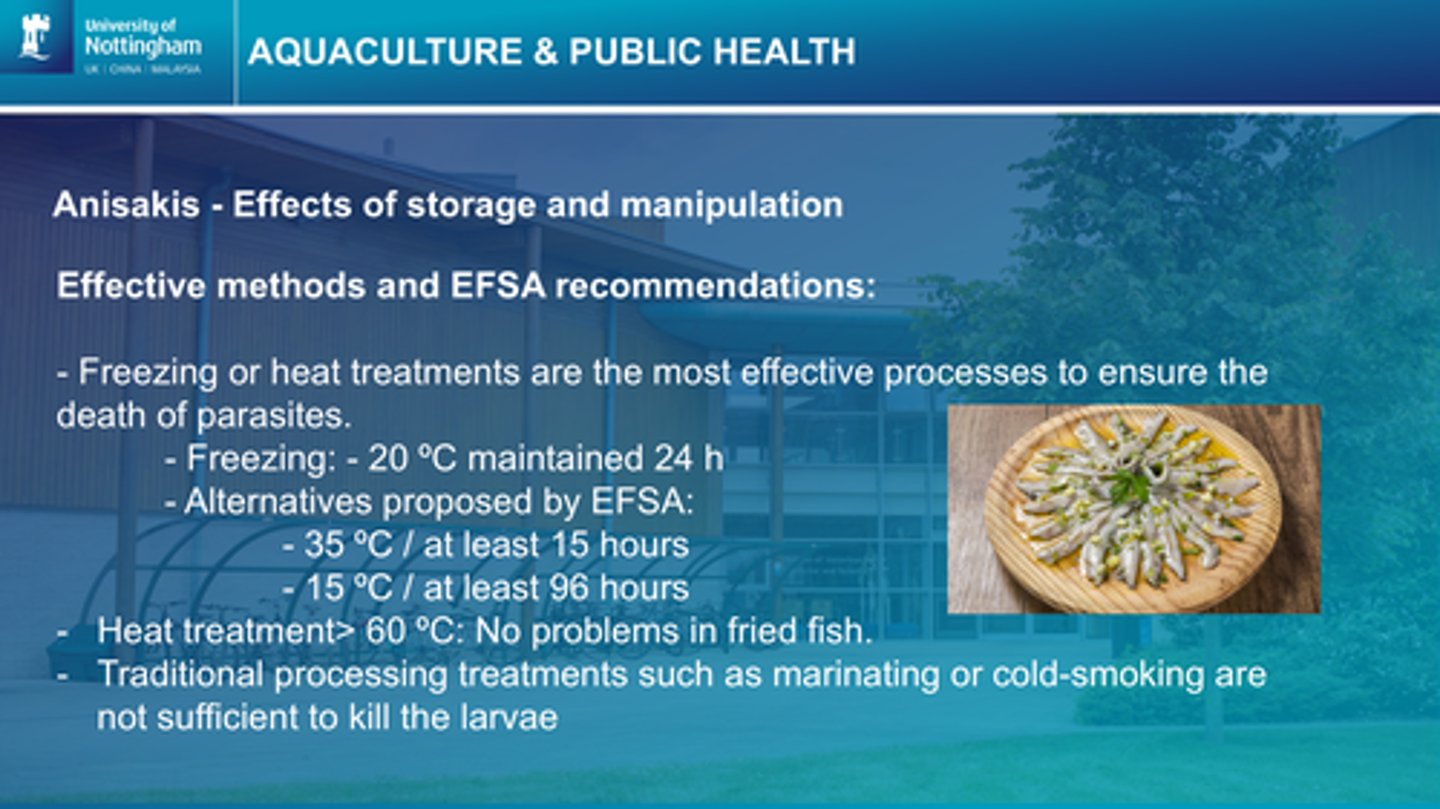
freezing and heat treatments for anisakis
freezing
-20 degrees C maintained 24 hrs
-35 degrees C for 15 hours
-15 degrees C for 96 hours
heat treatment >60 degrees c no problems for fried fish
traditional processing treatments - cold smoking - not sufficient to kill larvae
Describe the distribution of A.simplex (nematode) in fish
-Worldwide in marine water fish (only occasional in freshwater fish)
-Aquaculture fish are not parasitized (rare exceptions)
-Between 40-80% of marine fish are infested with larvae
-There is a higher prevalence in fish from cold waters
what cold water fish can Anisakis be commonly found in
meditarranean - hake, blue whitling, mackeral
atlantic ocean - hake, blue whitling, mackeral, herring, cod redfish, halibut, turbot
Anisakis larvae location in the fish
- free in the peritoneal cavity
- forming very numerous tangles attached to the peritoneum
- larvae coiled in a flat spiral and encapsulated in peritoneum, mesentery, liver or muscles often hypoxial
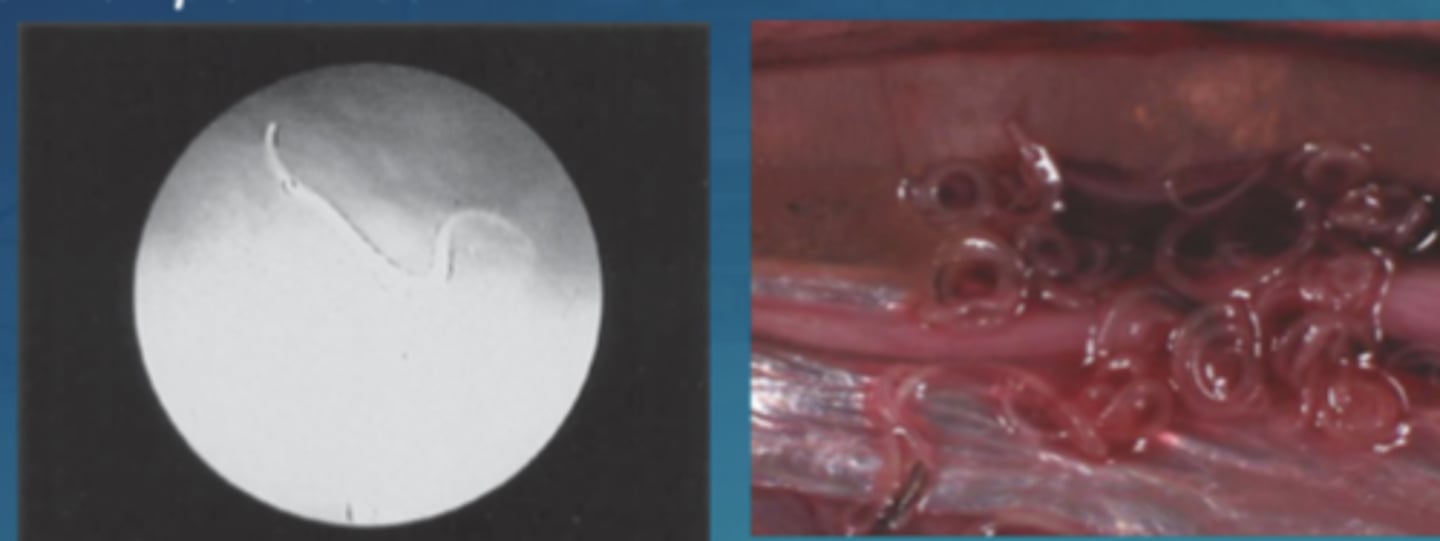
What are the key challenges that vets in aquaculture work face in practice?
1.Endemic disease
2.Antimicrobial resistance (AMR)
3.Biosecurity
4.Water quality, carrying capacity and effect on fish health/welfare
5.Lack of fish health infrastructure (training, vets, regulation)W